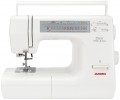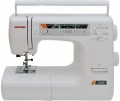Features
—
Alphabet letter embroidery. The ability to embroider letters of the alphabet using a machine. This function is found in computerized models. It is carried out due to a set of letters entered into the memory of the machine. Many models with this feature have several built-in fonts, and some even allow you to upload your fonts from your computer.
—
Differential bottom feed. The fabric feed consists of two gear racks — in front of and behind the needle. Depending on the set mode, such a feed can additionally stretch or, conversely, collect fabric during sewing; the first is useful when working with dense fabrics, the second — for knitwear, stretch and other easily stretching materials.
—
Reverse stitching. A function that allows you to switch the direction of movement of the fabric under the needle and, accordingly, the direction of the seam. Mainly used for stitching. The reverse is practically obligatory for sewing machines in the classical sense of the word — electromechanical, computerized and sewing-embroidery (see "Type"), but practically does not occur in other types.
— Free arm. A device for working with sleeves, trousers and other similar parts of clothing. This function is most often implemented due to the removable part of the desktop — when it is removed, the table turns into a narrow platform. The specific width of such a device ma
...y be different, it should be specified separately.
— Needle threader. A special device designed to facilitate the process of threading a needle. The presence of a needle threader is especially useful when changing threads frequently (for example, sewing alternately with different colours).
— Thread cutter. A mechanism for cutting the threads after sewing, eliminating the need to use scissors: to cut the thread, just press the button. Note that we are talking about an automatic thread cutter; hand tools mounted on the bodies of some machines are not considered thread cutters in this case.
— Pedal free sewing. The ability to use the machine without connecting the pedal. To start and stop the process in such models, usually, a special button is provided. Such an opportunity can be useful for long sewing when it would be tiring to keep the pedal constantly depressed, and for occasional use, when the machine starts “for a couple of stitches” and there is no need to fiddle with connecting the pedal.
— Twin needle sewing. The possibility of using a machine for sewing with a twin needle — a pair of needles fixed in one holder. There are different types of such needles and different methods of working with them, and some work is done only with a double needle. Anyway, the use of such devices requires that the machine be initially compatible with them.
— Needle stop switch (top/bottom). A switch that allows the user to select whether the needle will be in the up or down position after the motor stops. In the absence of such a switch, the needle, usually, stops only in the upper position, and this is not always convenientAdjustments
—
Presser foot pressure adjustment. The ability to change the degree of pressure of the foot on the fabric, adjusting it to the thickness of the material: for thin fabrics (chiffon, knitwear), the pressure should be small, for thick ones — on the contrary.
—
Thread tension regulator. A device that allows you to adjust the degree of tension of the upper thread. A mismatch in tension between the top and bottom threads causes one of the threads to pull the other and the seam deteriorates. To avoid this phenomenon, this function is provided. Note that tension adjustment is also possible for the lower thread — it is carried out through the shuttle (all shuttles have this option). But for this, it is necessary to remove the bobbin case or even the entire shuttle. The top regulator is located directly on the body of the machine, and it is much easier to use it.
—
Puncture force stabilizer. A device that provides a stable puncture force regardless of the engine speed. A feature of the mechanics of electric motors is that without special adjustment, the puncture force decreases markedly with an increase in speed. This function allows you to maintain approximately the same level over the entire speed range, which has a positive effect on the quality of work.
—
Feed shutdown. Possibility to turn off the bottom feed of the
...machine. This feature is indispensable for work in which the fabric needs to be shifted manually — for example, embroidering along a complex contour on a typewriter without an embroidery unit, sewing on buttons, etc.
— Speed control. The ability to set a speed limit for the machine. Thanks to this function, you can not be afraid to "squeeze" the pedal — even with strong pressure, the machine will work at a given speed, and no faster. This feature is useful, in particular, in jobs where you need to carefully control the process.
— Knee lever. A device that allows you to raise the presser foot and lower the lower feed dog with a knee movement without removing your hands from the fabric. Such a device is useful for quilting and some types of embroidery.Led lighting
A built-in lighting system that illuminates the working table of the machine, which is made of LEDs. In addition to the bright illumination of the work area,
LED-light sewing machines also have lower energy consumption compared to classic lamps.
Power consumption
The power consumed by the machine during operation. Usually, the maximum power value is indicated in the characteristics.
Most of the electricity supplied to the machine is consumed by the engine, so this indicator primarily describes the power of the engine. The higher this power, the faster the machine can work and the better it is suitable for working with dense fabrics. However, there is no strict dependence here, much also depends on the general specialization of the unit.

